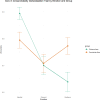Faces of different socio-cultural identities impact emotional meaning learning for L2 words
- PMID: 39753658
- PMCID: PMC11699134
- DOI: 10.1038/s41598-024-84347-7
Faces of different socio-cultural identities impact emotional meaning learning for L2 words
Erratum in
-
Author Correction: Faces of different socio-cultural identities impact emotional meaning learning for L2 words.Sci Rep. 2025 Feb 25;15(1):6747. doi: 10.1038/s41598-025-90727-4. Sci Rep. 2025. PMID: 40000699 Free PMC article. No abstract available.
Abstract
This study investigated how exposure to Caucasian and Chinese faces influences native Mandarin-Chinese speakers' learning of emotional meanings for English L2 words. Participants were presented with English pseudowords repeatedly paired with either Caucasian faces or Chinese faces showing emotions of disgust, sadness, or neutrality as a control baseline. Participants' learning was evaluated through both within-modality (i.e., testing participants with new sets of faces) and cross-modality (i.e., testing participants with sentences expressing the learned emotions) generalization tests. When matching newly learned L2 words with new faces, participants from both groups were more accurate under the neutral condition compared to sad condition. The advantage of neutrality extended to sentences as participants matched newly learned L2 words with neutral sentences more accurately than with both disgusting and sad ones. Differences between the two groups were also found in the cross-modality generalization test in which the Caucasian-face Group outperformed the Chinese-face Group in terms of accuracy in sad trials. However, the Chinese-face Group was more accurate in neutral trials in the same test. We thus conclude that faces of diverse socio-cultural identities exert different impacts on the emotional meaning learning for L2 words.
Keywords: Disgust; Faces; Pseudowords; Sadness; Second language.
© 2024. The Author(s).
Conflict of interest statement
Competing interests: The authors declare no competing interests.
Figures







Similar articles
-
Differential emotion attribution to neutral faces of own and other races.Cogn Emot. 2017 Feb;31(2):360-368. doi: 10.1080/02699931.2015.1092419. Epub 2015 Oct 14. Cogn Emot. 2017. PMID: 26465265
-
ERP evidence for emotion-specific congruency effects between sentences and new words with disgust and sadness connotations.Front Psychol. 2023 May 12;14:1154442. doi: 10.3389/fpsyg.2023.1154442. eCollection 2023. Front Psychol. 2023. PMID: 37251037 Free PMC article.
-
Blinded by taboo words in L1 but not L2.Emotion. 2012 Apr;12(2):217-22. doi: 10.1037/a0026387. Epub 2012 Jan 16. Emotion. 2012. PMID: 22251052
-
The automatic activation of emotion words measured using the emotional face-word Stroop task in late Chinese-English bilinguals.Cogn Emot. 2018 Mar;32(2):315-324. doi: 10.1080/02699931.2017.1303451. Epub 2017 Mar 23. Cogn Emot. 2018. PMID: 28332423
-
Processing advantage for emotional words in bilingual speakers.Emotion. 2015 Oct;15(5):644-52. doi: 10.1037/emo0000061. Epub 2015 Apr 20. Emotion. 2015. PMID: 25893450
References
-
- Clement, F., Bernard, S., Grandjean, D. & Sander, D. Emotional expression and vocabulary learning in adults and children. Cogn. Emot.27, 539–548 (2013). - PubMed
-
- Ekman, P. Facial expressions of emotion: new findings, new questions. Psychol. Sci.3, 34–38 (1992).
-
- Ekman, P. Facial expression and emotion. Am. Psychol.48, 384–392 (1993). - PubMed
-
- Brigham, J. C., Bennett, L. B., Meissner, C. A. & Mitchell, T. L. The influence of race on eyewitness memory. Handb. Eyewitness Psychol. Vol. II Mem. People2, 257–281 (2007).
-
- Yan, X., Andrews, T. J., Jenkins, R. & Young, A. W. Cross-cultural differences and similarities underlying other-race effects for facial identity and expression. Q. J. Exp. Psychol.69, 1247–1254 (2016). - PubMed
Publication types
MeSH terms
Grants and funding
LinkOut - more resources
Full Text Sources

